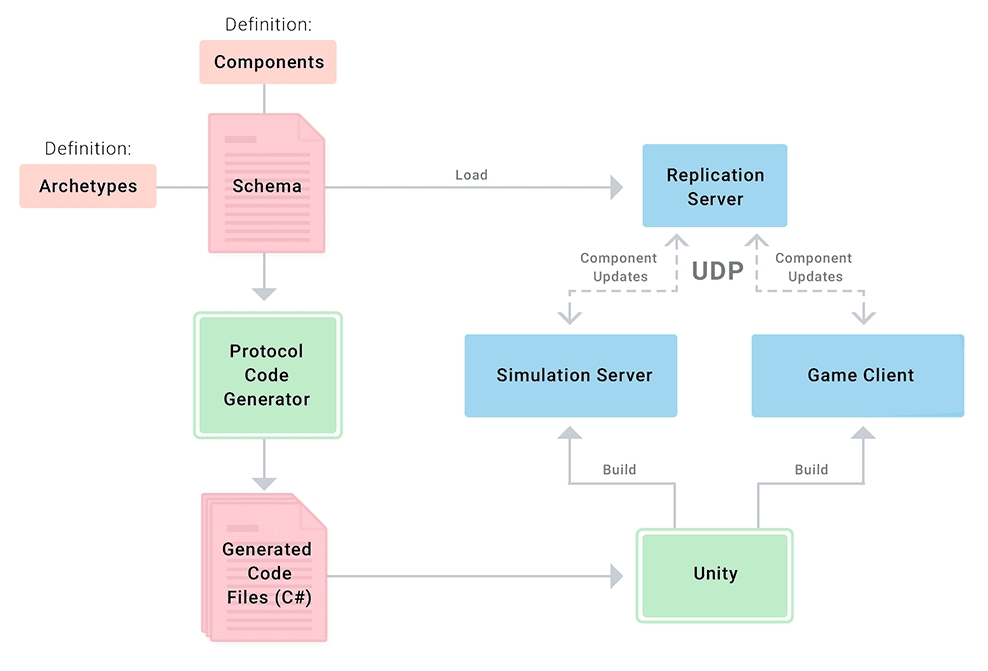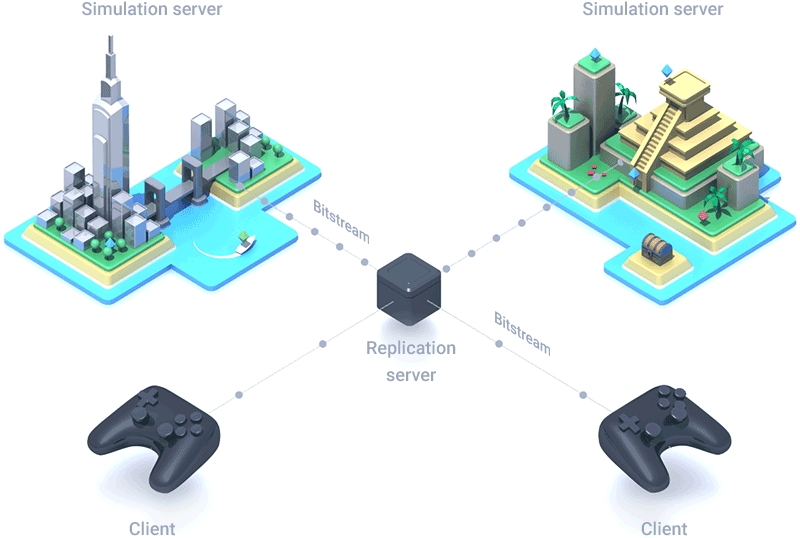
coherence works by sharing game world data via a Replication Server in the cloud and passing it to the connected Clients.
The Clients and Simulators can define areas of interest (LiveQueries), levels of detail, varying simulation and replication frequencies and other optimization techniques to control how much bandwidth and CPU power is used in different situations.
The game world can be run using multiple Simulators that split up simulation functions or areas of the world accordingly.
Fast authority transfer and remote commands allow different authority models, including Client authority, Server authority, distributed authority and combinations like Client prediction with input queues.
The platform handles scaling, synchronization, persistence and load balancing automatically.
A lean and performant server that keeps the state of the world and replicates it efficiently between various Simulators and Game Clients. The Replication Server usually runs in the coherence Cloud, but developers can start it locally from the command line or the Unity Editor.
A build of the game. To connect to coherence, it will use the coherence SDK.
A Simulator is a version of the Game Client without the graphics ("headless client") optimized and configured to perform server-side simulation of the game world. When we say something is simulated on the server, we mean it is simulated on one or several Simulators.
A text file defining the structure of the world from the network's point of view. The schema is shared between the Replication Servers, Simulators and Game Clients. The world is generally divided in components and archetypes.
Code generation ("Baking")
This is the process of generating code specific to the game engine that takes care of network synchronization and other network-specific code. This is also known as Baking and is done using a CLI tool called Protocol Code Generator that takes the schema file and generates code for various engines (e.g. C# for Unity).
The process of making sure the state of the world is eventually the same on the Replication Servers, Simulators and Game Clients, depending on their areas of interest.
coherence works by sharing game world data via a Replication Server in the cloud and passing it to the connected Clients.
The Clients and Simulators can define areas of interest (LiveQueries), levels of detail, varying simulation and replication frequencies and other optimization techniques to control how much bandwidth and CPU power is used in different situations.
The game world can be run using multiple Simulators that split up simulation functions or areas of the world accordingly.
Fast authority transfer and remote commands allow different authority models, including Client authority, Server authority, distributed authority and combinations like Client prediction with input queues.
The platform handles scaling, synchronization, persistence and load balancing automatically.
Peer-to-peer support (without a Replication Server) is available starting from coherence version 1.0.
Custom UDP transport layer using bit streams with reliability
WebRTC support for WebGL builds
Smooth state replication
Server-side, Client-side, distributed authority
Connected entity support
Fast authority transfer
Remote messaging (RPC)
Persistence
Verified support for Windows, macOS, Linux, Android, iOS and WebGL
Support for Rooms and Worlds
Floating Origin for extremely large virtual Worlds
TCP Fallback
Support for Client hosting through Steam Datagram Relay
Unity SDK with an intuitive no-code layer
Per-field adjustable interpolation and extrapolation
Input queues
Easy deployment into the cloud
Multi-room Simulators
Multiple code generation strategies (Assets/Baking, automated with C# Source Generators)
Extendable object spawning strategies (Resources, Direct References, Addressables) or implement your own
Per-field compression and quantization
Per-field sampling frequency adjustable at runtime
Unlimited per-field levels of detail
Areas of interest
Accurate SimulationFrame tracking
Network profiler
Brand new developer portal for management and usage statistics
Automatic server deployment and scaling
Multiple regions in the US, Europe and Asia
Player accounts with a persistent key/value store
Matchmaking and lobby rooms
Float64 support
Permissions and roles system for clients and simulators
Input queue UX improvements
More logging and diagnostics tools
Built-in network condition simulation
Additional server regions
Support for multiple Simulators and Replicators in a single project
Support for lean pure C# clients and simulators without Unity
Peer-to-peer (without replication server) with NAT punch-through
MTU detection
Packet replay
Ability to deploy multiple Simulation Servers per environment
Player analytics
Developer portal graphs and analytics
Simulator authentication
Bare-metal and cloud support
Misprediction detection support
SDK library that can be used in C++ and other languages
More starter/sample projects and helper scripts
Ability to embed WebGL games in web portals
Global KV-Store
Complex data types/entities in the KV store
More GGPO support for specific game genres
Misprediction detection support
Unreal Engine SDK
JavaScript SDK
Advanced matchmaking
Multiple Replication Servers per game world
Customer-specific serialization
User-space load-balancing (SDK framework)
Game world map with admin interface
Advanced anti-cheat functionality
Advanced transaction logs (audit trail)
Schema versioning (hot updates)
Console-specific updates
Player analytics
coherence is a network engine, platform and a series of tools to help anyone create a multiplayer game.
Fast network engine with cloud scaling, state replication, persistence and auto load balancing.
Easy to develop, iterate and operate connected games and experiences.
SDK allows developers to make multiplayer games using Windows, Linux or Mac, targeting desktop, console, mobile, VR or the web.
Game engine plugins and visual tools will help even non-coders create and quickly iterate on a connected game idea.
Scalable from small games to large virtual worlds running on hundreds of servers.
Game-service features like user account and key-value stores.
At the core of coherence lies a fast network engine based on bitstreams and a data-oriented architecture, with numerous optimization techniques like delta compression, quantization and network LOD-ing ("Level of Detail") to minimize bandwidth and maximize performance.
The network engine supports multiple authority models:
Client authority
Server authority
Server authority with client prediction
Authority handover (request, steal)
Distributed authority (multiple simulators with seamless transition)
Deterministic client prediction with rollback ("GGPO") - experimental
Sounds interesting? Check out the full article on Authority.
coherence supports persistence out of the box.
This means that the state of the world is preserved no matter if clients or simulators are connected to it or not. This way, you can create shared worlds where visitors have a lasting impact.
Here's more info on how coherence handles Persistence.
The coherence SDK only supports Unity at the moment. Unreal Engine support is planned. For more specific details and announcements, please check the Unreal Engine Support page. For custom engine integration, please contact our developer relations team.
coherence provides two types of spaces where realtime gameplay can happen: Rooms and Worlds. In addition to these, Lobbies provide functionality for players to meet before a match, and to chat.
Read the differences between these in this quick overview.
Rooms are best for session-based gameplay where the match between players takes place in a short-lived environment.
A good example is a first person shooter multiplayer match. The match takes place between two teams in a single game session, and players enter through a lobby and matchmaking. When the match is concluded, the multiplayer environment the match took place in (the Room) is closed and players return to a lobby.
This is one example of how Rooms can be used, but it is by no means the only use case. The important distinction between Rooms and Worlds (see below) is that Rooms are relatively short-lived and are meant to be created and closed by the Game Client through the coherence SDK.
See Rooms API.
Worlds, as opposed to Rooms, are long-lived and permanent multiplayer environments provided by coherence. Using the Developer Portal, your project will easily define and manage your World configurations.
See Worlds API.
A good example of a World is a permanent environment for an Massively Multiplayer Game (MMO). Regardless of the number of players connected, the environment is always available, and players can connect and disconnect at will.
Entities can be permanently saved in the World so that even if there are no active connections, they still persist when players do connect.
Your project does not have to choose one or the other. A project in coherence can contain both World and Rooms.
The primary difference in the configuration and usage of Room and Worlds is that Worlds are managed in the Developer Portal, whereas Rooms are created and managed through the SDK.
A good example of this scenario is again, our MMO. Although players connect to a permanent and persistent World, they may enter a dungeon instance with other players. These dungeon instances can be Rooms.
Lobbies are a convenient way to do matchmaking between player accounts, filter players based on their attributes, and provide a way for them to communicate among each other.
Use case
Continuing from our MMO example (a World), you have now implemented dungeon instances that take place in Rooms. But how to best allow players to organize themselves into groups to enter these instances? This is what Lobbies are used for. You can create your own restrictions on player count, level, etc., but Lobbies could also allow the players that create them to set specific restrictions based on level or class.
See Lobbies.

